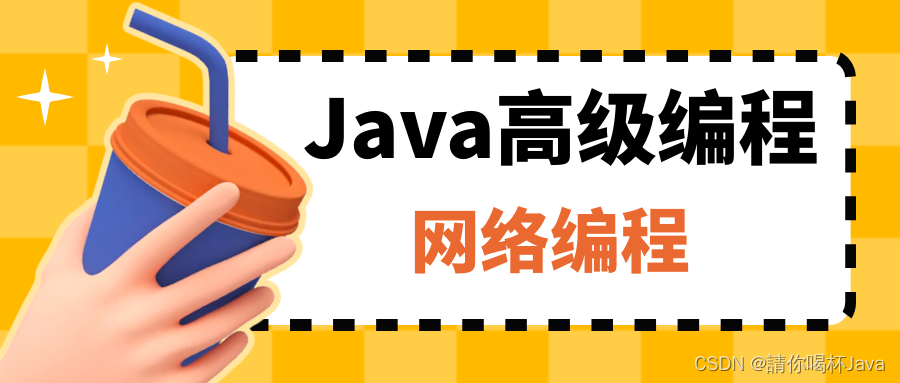【Java高级编程】网络编程

【Java核心技术】Java基本语法
【Java核心技术】Java面向对象编程
【Java核心技术】Java异常处理
【Java高级编程】Java多线程
【Java高级编程】Java常用类
【Java高级编程】Java枚举类&注解
【Java高级编程】Java集合
【Java高级编程】Java泛型
【Java高级编程】JavaIO流
【Java高级编程】Java网络编程
【Java高级编程】Java反射机制
【Java高级编程】Java8的新特性
网络编程
- 1、InetAddress类的使用
- 1.1、实现网络通信需要解决的两个问题
- 1.2、网络通信的两个要素
- 1.3、通信要素一:IP和端口号
- 1.4、通信要素二:网络通信协议
- 1.5、TCP和UDP的区别
- 1.6、TCP三次握手和四次挥手
- 2、TCP网络编程
- 3、UDP网络编程
- 4、URL编程
- 4.1、URL(Uniform Resource Locator)的理解
- 4.2、URL的5个基本结构
- 4.3、如何实例化
- 4.4、常用方法
- 4.5、可以读取、下载对应的url资源
1、InetAddress类的使用
1.1、实现网络通信需要解决的两个问题
- 如何准确地定位网络上一台或多台主机;定位主机上的特定的应用
- 找到主机后如何可靠高效地进行数据传输
1.2、网络通信的两个要素
- 对应问题一:IP和端口号
- 对应问题二:提供网络通信协议:TCP/IP参考模型(应用层、传输层、网络层、物理+数据链路层)
1.3、通信要素一:IP和端口号
IP的理解
- IP:唯一的标识Internet上的计算机(通信实体)
- 在Java中使用InetAddress类代表IP
- IP分类:IPv4和IPv6;万维网和局域网
域名:www.baidu.com、www.mi.com
- 域名解析:域名容易记忆,当在连接网络时输入一个主机的域名后,域名服务器(DNS)负责将域名转化成IP地址,这样才能和主机建立连接。
- 本地回路地址:127.0.0.1 对应着:localhost
InetAddress类:此类的一个对象就代表着一个具体的IP地址
实例化:
- getByName(String host)
- getLocalHost()
常用方法:
- getHostName()
- getHostAddress()
端口号:正在计算机上运行的进程
- 要求:不同的进程不同的端口号
- 范围:被规定为一个16位的整数 0~65535
- 端口号与IP地址的组合得出一个网络套接字:Socket
1.4、通信要素二:网络通信协议
| OSI参考模型 | TCP/IP参考模型 | TCP/IP参考模型各层对应协议 |
|---|---|---|
| 应用层、表示层、会话层 | 应用层 | HTTP、FTP、Telnet、DNS… |
| 传输层 | 传输层 | TCP、UDP… |
| 网络层 | 网络层 | IP、ICMP、ARP… |
| 数据链路层、物理层 | 物理+数据链路层 | Link |
1.5、TCP和UDP的区别
TCP协议:
- 使用TCP协议前,须先建立TCP连接,形成传输数据通道
- 传输前,采用“三次握手”方式,点对点通信,是可靠的
- TCP协议进行通信的两个应用进程:客户端、服务端
- 在连接中可进行大数据量的传输
- 传输完毕,需要释放已建立的连接,效率低
UDP协议:
- 将数据、源、目的封装成数据包,不需要建立连接
- 每个数据报的大小限制在64K内
- 发送不管对方是否准备好,接收方收到也不确认,故是不可靠的
- 可以广播发送
- 发送数据结束时无需释放资源,开销小,速度快
1.6、TCP三次握手和四次挥手
- 三次握手
客户端服务端seq=x,SYN=1客户端发送syn报文,并置发送序号为xACK=x+1,seq=y,SYN=1服务端发送syn+ACK报文并置发送序号为y,再确定序号为x+1ACK=y+1,seq=z客户端发送ACK报文,并置发送序号为z再确定序号为Y+1客户端服务端
- 四次挥手
主动方被动方Fin=1,Ack=z,seq=x主动方发送Fin+Ack报文,并置发送序号为XACK=x+1,seq=z被动方发送ACK报文,并置发送序号为Z,再确定序号为X+1Fin=1,ack=x,seq=y被动方发送Fin+Ack报文,并置发送序号为Y,再确定序号为XACK=Y,seq=x主动方发送ack报文,并置发送序号为X,再确认序号为Y主动方被动方
2、TCP网络编程
/*** 客户端发送信息给服务端,服务端将数据显示在控制台上*/public class TCPTest1 {// 客户端@Testpublic void client() {Socket socket = null;OutputStream os = null;try {// 1、创建Socket对象,指明服务器端的IP和端口号InetAddress inet = InetAddress.getByName("127.0.0.1");socket = new Socket(inet, 8899);// 2、获取一个输出流,用于输出数据os = socket.getOutputStream();// 3、写出数据的操作os.write("你好,我是客户端mm".getBytes());} catch (IOException e) {e.printStackTrace();} finally {// 4、资源的关闭if (os != null) {try {os.close();} catch (IOException e) {e.printStackTrace();}}if (socket != null) {try {socket.close();} catch (IOException e) {e.printStackTrace();}}}}//服务端@Testpublic void server () {ServerSocket ss = null;Socket socket = null;InputStream is = null;ByteArrayOutputStream baos = null;try {// 1、创建服务器端的ServerSocket,指明自己的端口号ss = new ServerSocket(8899);// 2、调用accept()表示接收来自客户端的socketsocket = ss.accept();// 3、获取输入流is = socket.getInputStream();// 4、读取输入流中的数据baos = new ByteArrayOutputStream();byte[] buffer = new byte[5];int len;while ((len = is.read(buffer)) != -1) {baos.write(buffer, 0, len);}System.out.println(socket.getInetAddress().getHostAddress() + ":" + baos.toString());} catch (IOException e) {e.printStackTrace();} finally {// 5、关闭资源if (baos != null) {try {baos.close();} catch (IOException e) {e.printStackTrace();}}if (is != null) {try {is.close();} catch (IOException e) {e.printStackTrace();}}if (socket != null) {try {socket.close();} catch (IOException e) {e.printStackTrace();}}if (ss != null) {try {ss.close();} catch (IOException e) {e.printStackTrace();}}}}}/*** 客户端发送文件给服务端,服务端将文件保存在本地*/public class TCPTest2 {// 客户端@Testpublic void client () {Socket socket = null;OutputStream os = null;FileInputStream fis = null;try {socket = new Socket(InetAddress.getByName("127.0.0.1"), 9090);os = socket.getOutputStream();fis = new FileInputStream(new File("beauty.jpg"));byte[] buffer = new byte[1024];int len;while ((len = fis.read(buffer)) != -1) {os.write(buffer, 0, len);}} catch (IOException e) {e.printStackTrace();} finally {if (fis != null) {try {fis.close();} catch (IOException e) {e.printStackTrace();}}if (os != null) {try {os.close();} catch (IOException e) {e.printStackTrace();}}if (socket != null) {try {socket.close();} catch (IOException e) {e.printStackTrace();}}}}//服务端@Testpublic void server () {ServerSocket ss = null;Socket socket = null;InputStream is = null;FileOutputStream fos = null;try {ss = new ServerSocket(9090);socket = ss.accept();is = socket.getInputStream();fos = new FileOutputStream(new File("beauty1.jpg"));byte[] buffer = new byte[1024];int len;while ((len = is.read(buffer)) != -1) {fos.write(buffer, 0, len);}} catch (IOException e) {e.printStackTrace();} finally {if (fos != null) {try {fos.close();} catch (IOException e) {e.printStackTrace();}}if (is != null) {try {is.close();} catch (IOException e) {e.printStackTrace();}}if (socket != null) {try {socket.close();} catch (IOException e) {e.printStackTrace();}}if (ss != null) {try {ss.close();} catch (IOException e) {e.printStackTrace();}}}}}/*** 从客户端发送文件给服务器,服务端保存到本地。并返回“发送成功”给客户端* 并关闭相关的连接*/public class TCPTest3 {// 客户端@Testpublic void client (){Socket socket = null;OutputStream os = null;FileInputStream fis = null;InputStream is = null;ByteArrayOutputStream baos = null;try {socket = new Socket(InetAddress.getByName("127.0.0.1"), 9090);os = socket.getOutputStream();fis = new FileInputStream(new File("beauty.jpg"));byte[] buffer = new byte[1024];int len;while ((len = fis.read(buffer)) != -1) {os.write(buffer, 0, len);}// 关闭数据的输出socket.shutdownOutput();// 接收来自于服务器端的数据,并显示到控制台上is = socket.getInputStream();baos = new ByteArrayOutputStream();byte[] buffer1 = new byte[20];int len1;while ((len1 = is.read(buffer1)) != -1) {baos.write(buffer1, 0, len1);}System.out.println(baos.toString());} catch (IOException e) {e.printStackTrace();} finally {if (baos != null) {try {baos.close();} catch (IOException e) {e.printStackTrace();}}if (is != null) {try {is.close();} catch (IOException e) {e.printStackTrace();}}if (fis != null) {try {fis.close();} catch (IOException e) {e.printStackTrace();}}if (os != null) {try {os.close();} catch (IOException e) {e.printStackTrace();}}if (socket != null) {try {socket.close();} catch (IOException e) {e.printStackTrace();}}}}// 服务端@Testpublic void server () {ServerSocket ss = null;Socket socket = null;InputStream is = null;FileOutputStream fos = null;OutputStream os = null;try {ss = new ServerSocket(9090);socket = ss.accept();is = socket.getInputStream();fos = new FileOutputStream(new File("beauty2.jpg"));byte[] buffer = new byte[1024];int len;while ((len = is.read(buffer)) != -1) {fos.write(buffer, 0, len);}System.out.println("图片传输完成");// 服务器端给予客户单反馈os = socket.getOutputStream();os.write("你好,美女,照片我已收到,非常漂亮!".getBytes());} catch (IOException e) {e.printStackTrace();} finally {if (os != null) {try {os.close();} catch (IOException e) {e.printStackTrace();}}if (fos != null) {try {fos.close();} catch (IOException e) {e.printStackTrace();}}if (is != null) {try {is.close();} catch (IOException e) {e.printStackTrace();}}if (socket != null) {try {socket.close();} catch (IOException e) {e.printStackTrace();}}if (ss != null) {try {ss.close();} catch (IOException e) {e.printStackTrace();}}}}}
3、UDP网络编程
public class UDPTest {// 发送端@Testpublic void sender () {DatagramSocket socket = null;try {socket = new DatagramSocket();String str = "我是UDP方式发送的导弹";byte[] data = str.getBytes();InetAddress inet = InetAddress.getLocalHost();DatagramPacket packet = new DatagramPacket(data, 0, data.length, inet, 9090);socket.send(packet);} catch (IOException e) {e.printStackTrace();} finally {if (socket != null) {socket.close();}}}// 接收端@Testpublic void receiver () {DatagramSocket socket = null;try {socket = new DatagramSocket(9090);byte[] buffer = new byte[100];DatagramPacket packet = new DatagramPacket(buffer, 0, buffer.length);socket.receive(packet);System.out.println(new String(packet.getData(), 0, packet.getLength()));} catch (IOException e) {e.printStackTrace();} finally {socket.close();}}}
4、URL编程
4.1、URL(Uniform Resource Locator)的理解
- 统一资源定位符,对应着互联网的某一资源地址
4.2、URL的5个基本结构
- 协议
- 主机名
- 端口号
- 资源地址
- 参数列表
4.3、如何实例化
URL url = new URL("http://localhost:8080/examples/beauty.jpg?username=Tom")
4.4、常用方法
- public String getProtocol():获取该URL的协议名
- public String getHost():获取该URL的主机名
- public String getPort():获取该URL的端口号
- public String getPath():获取该URL的文件路径
- public String getFile():获取该URL的文件名
- public String getQuery():获取该URL的查询名
4.5、可以读取、下载对应的url资源
public static void main(String[] args) {HttpURLConnection urlConnection = null;InputStream is = null;FileOutputStream fos = null;try {URL url = new URL("http://localhost:8080/examples/beauty.jpg");urlConnection = (HttpURLConnection) url.openConnection();urlConnection.connect();is = urlConnection.getInputStream();fos = new FileOutputStream("day10\\beauty3.jpg");byte[] buffer = new byte[1024];int len;while ((len = is.read(buffer)) != -1) {fos.write(buffer, 0, len);}System.out.println("下载完成");} catch (IOException e) {e.printStackTrace();} finally {if (fos != null) {try {fos.close();} catch (IOException e) {e.printStackTrace();}}if (is != null) {try {is.close();} catch (IOException e) {e.printStackTrace();}}if (urlConnection != null) {urlConnection.disconnect();}}}



































还没有评论,来说两句吧...